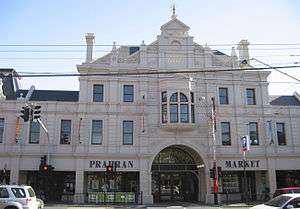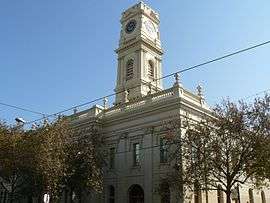Prahran, Victoria
Prahran (IPA: /prəˈræn/), also known colloquially as Pran, is an inner suburb of Melbourne, Victoria, Australia, 5 km south-east of Melbourne's Central Business District, located within the City of Stonnington local government area. At the 2016 Census Prahran had a population of 12,982.[1]
| Prahran Melbourne, Victoria | |||||||||||||||
|---|---|---|---|---|---|---|---|---|---|---|---|---|---|---|---|
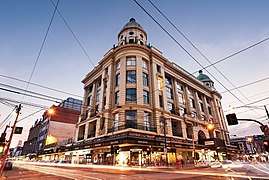 Pran Central on the corner of Chapel Street and Commercial Road | |||||||||||||||
 Prahran | |||||||||||||||
| Coordinates | 37.852°S 144.998°E | ||||||||||||||
| Population | 12,982 (2016)[1] | ||||||||||||||
| • Density | 6,180/km2 (16,000/sq mi) | ||||||||||||||
| Established | 1837 | ||||||||||||||
| Postcode(s) | 3181 | ||||||||||||||
| Area | 2.1 km2 (0.8 sq mi) | ||||||||||||||
| Location | 5 km (3 mi) from Melbourne | ||||||||||||||
| LGA(s) | City of Stonnington | ||||||||||||||
| State electorate(s) | Prahran | ||||||||||||||
| Federal Division(s) | Higgins | ||||||||||||||
| |||||||||||||||
Prahran is a part of Greater Melbourne, with many shops, restaurants and cafes.
The shopping street Chapel Street is a mix of upscale fashion boutiques and cafes. Greville Street, once the centre of the Melbourne's hippie community, has many cafés, bars, restaurants, bookstores, clothing shops and music shops.
Prahran takes its name from Pur-ra-ran, a Woiwurrung word which was thought to mean "land partially surrounded by water".[2] The word has more recently been identified as a transcription of "Birrarung", the name for the Yarra River, or a specific point of it.[3]
History
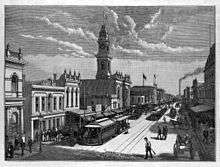

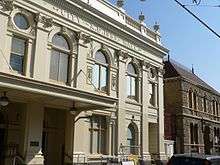
In 1837 George Langhorne named the area Pur-ra-ran, which was thought to be a compound of two Aboriginal words, meaning "land partially surrounded by water". The word has more recently been identified as a transcription of "Birrarung", the name for the Yarra River or a specific point of it.[3] When Langhorne informed the Surveyor-General Robert Hoddle of the name, it was written as "Prahran".[4]
Prahran Post Office opened on 1 April 1853.[5]
Describing Prahran, as it was in the mid 1850s, F.R. Chapman remembered:
In the very early times Chapel-street had many vacant spaces. On the west side, about the middle, a man could be seen ploughing his farm... and on the same side was a small brick church, or more probably a school-room used as a church, which was known as Mr Gregory's.[6]

Between the 1890s and 1930s Prahran built up a huge shopping centre, which by the 1920s had rivalled the Melbourne Central Business District. Large emporiums (department stores) sprang up along Chapel Street. Prahran also became a major entertainment area. The Lyric theatre (also known as the fleahouse), built on the corner of Victoria Street in 1911, burnt down in the 1940s. The Royal was the second old theatre built. The Empress (also known as the flea palace), another popular theatre on Chapel Street, was destroyed by fire in 1971.[7] The site was operated by the cut-price clothes and homewares chain Waltons for the next decade and was later developed into the Chapel Street Bazaar.
In the 1960s, in an effort to boost the slowly growing local population and inject new life into the suburb, the Victorian Government opened the Prahran Housing Commission estate, just off Chapel Street, together with a larger estate, located just north in South Yarra. Further complementing the high rise developments was a low density development between Bangs and Bendigo Streets.
In the 1970s, the suburb began to gentrify, with much of the remaining old housing stock being renovated and restored. The area had a substantial Greek population and many took advantage of the rise in property values during the 1980s, paving the way for further development and a subsequent shift in demographics.
During the 1990s, the population increased markedly, with demand for inner-city living fuelling a medium-density housing boom, which continues in the area, as part of the Melbourne 2030 planning policy. It was during the 1990s that solidification of the area's gay community occurred. Many gay and gay-friendly businesses (including last of these closing around 2012.
Demographics
In the 2016 Census, there were 12,982 people in Prahran. 57.6% of people were born in Australia. The next most common countries of birth were England 4.5%, New Zealand 3.7%, Greece 3.0%, China 1.7% and India 1.5%. 68.5% of people spoke only English at home. Other languages spoken at home included Greek 5.0%, Mandarin 2.0%, French 1.2%, Spanish 1.1% and Italian 1.0%. The most common responses for religion were No Religion 42.5% and Catholic 15.9%.[1]
Local landmarks
Non-residential architecture
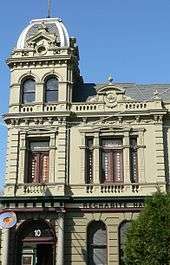
Prahran is home to a large collection of architecturally significant commercial buildings, with many on the Victorian Heritage Register.
The Chapel Street section of Prahran is notable for its collection of turn of the century emporiums and large buildings, which include:
- Prahran Arcade – Built in 1889 on Chapel Street, is a richly detailed building both externally and internally. Retains the original arcade, but decorative roof was removed in the 1950s. Also known locally as "Birdland" due to pigeons which once bred in the recessed balconies of the building and the large eagles which adorn the facade, but are now screened by chicken wire. Was a Dan Murphy's cellar for many years, but currently a JB HiFi store. Now heritage registered.
- Reads Emporium – Built in 1914 on the corner of Chapel Street and Commercial Road. A landmark of the area. Its twin beacons, which sit atop large copper clad domes, were once visible like lighthouses for miles around, but no longer operate. During the 1970s, the site traded as a department store under the name Moore's before the lower stories were converted into shops in the 1980s and named Pran Central. The upper stories were restored and converted into fashionable apartments in 2005. Now heritage registered.
- Big Store – Built in 1902 and closed in 1968 on Chapel Street. A second store, almost as large as the main store, once stood in the carpark to the west, beyond Cato Street, linked by cross-over walkways. This large Edwardian building is currently used by Coles Supermarkets.
- Maples Corner – Built in 1910 on the corner of Chapel and High Streets. Converted into offices in the 1980s and many deteriorating decorative features were replaced with post modern elements.
- Love & Lewis – Built in 1913 on Chapel Street and converted into a mix of offices, retail and apartments in 2004. Now heritage registered.
Other significant Prahran emporiums include Conway's Buildings (1914) and the large Colosseum building (1897), which was lost to fire in 1914.
Other heritage buildings include the former Prahran Town Hall (now used as a library and council offices), the adjacent former City Hall (1888) (now used for special functions and as an exhibition space), the neighbouring police station (1887) and court house (1887) and Rechabite Hall (1888), in the Second Empire style. The Prahran Fire Tower (1889) is on Macquarie Street. State School number 2855, formerly Prahran Primary School (1888), on High Street was converted into apartments in 2005. St Matthew's Church, a large bluestone church on High Street built in the 1880s, was converted into offices in the 1980s.
Residential architecture
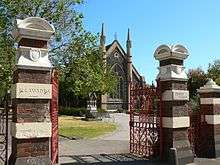
Residential Prahran consists of mostly single storey Victorian and Edwardian terrace houses, with some larger double storey terraces closer to the main shopping strips.
Public space
Prahran features many small (largely hidden) gardens scattered throughout the suburb. The former Greville Botanical Gardens, now "Grattan Gardens", are off Greville Street, on Grattan Street. Subdivisions have caused incursions to what is now a narrow strip, with a playground and heritage pavilion. The Princes Gardens are a small garden, which features Chapel Off Chapel, an old church converted into a theatre, as well as the Prahran skate park, home to the best vert skateboarding facilities in Victoria. Victoria Gardens, off High Street, is a Victorian era garden, with a main space consisting of a circular row of London plane trees and an angel statue. The Orrong Romanis Park is the largest park in Prahran, although the Cato Street carpark has been converted into an urban square named Prahran Square.
Education
Prahran was home to Prahran College,[8] a secondary and tertiary technical college and trade school that originated in Chapel Street as, and continued to be associated with, the Mechanics Institute. It incorporated an art school which particularly from around the 1960s produced graduates who went on to become significant Australians. From 1968 it was situated in a multi-storey building in High Street, demolished in 2017 for the construction by the Andrews government of a $25 million 'vertical' secondary college, next to Melbourne Polytechnic and the National Institute of Circus Arts, and which opened in 2019.[9] Alumni include painters Howard Arkley, Douglas Baulch, Christopher Beaumont, Peter Churcher, William Dargie, Robert Jacks, William Kelly, David Larwill; printmakers Basil Hadley and Merris Hillard; designers Mimmo Cozzolino and Martine Murray; photographers Robert Ashton, Andrew Chapman, Susan Fereday, Bill Henson, Carol Jerrems, Tony Maskill, Leonie Reisberg, Stephen Wickham and sculptor Stuart Devlin.
Transport
Prahran is serviced by Prahran station, on the Sandringham line, as well as trams routes 5, 6, 64, 72 and 78.
Notable people
- Graham Berry – (1822-1904) Colonial politician, and 11th Premier of Victoria, was a grocer in Prahran in the 1850s.[10]
- Maurice Blackburn – (1880-1944) Australian lawyer and Labor Party politician, who died in Prahran in 1944.
- Raelene Boyle – Australian athlete, who worked for the Prahran City Council as a landscape gardener.[11]
- Keith Campbell, first Australian to win a Grand Prix motorcycle racing world championship in 1957.[12]
- Barlow Carkeek – (1878-1937) Victorian and Australian cricketer died in Prahran in 1937.
- Walter Joseph Cawthorn – Soldier, diplomat and a former head of the Australian Secret Intelligence Service (ASIS) was born in Prahran in 1896.
- Percy Cerutty – Eccentric athletics coach of Herb Elliott was born in Prahran in 1895.
- Arthur Henry Cobby – Leading air ace in the Australian Flying Corps during World War I was born in Prahran.
- Paul Cox - film director who lived in Prahran and taught at Prahran College 1967-1980.
- John "Jack" Edwards – Test cricketer, was born in Prahran in 1860.
- Mark Evans (musician) – Bass guitarist with AC/DC from 1975–1977.
- Tony Gaze – WW2 fighter ace and first Australian racing driver to compete in an overseas Grand Prix, born in Prahran in 1920.
- Lisa Gerrard – Australian musician and singer, part of the music group Dead Can Dance, lived in Prahran.
- Lachy Hulme – Australian actor and screenwriter, lives in Prahran.
- Herbert Hyland – (1884-1970) Investor and Country Party politician, was born on 15 March 1884 in Prahran.
- Gertrude Johnson – 1894-1973) Soprano and founder of the National Theatre, born in Prahran in 1894.
- Chris Judd – Carlton Captain, has a luxury home in Prahran.
- George Hodges Knox – Australian politician, after whom the City of Knox is named, was born in Prahran in 1885.
- Sam Loxton – Australian Test cricketer, played for Prahran in Victorian Premier Cricket, later represented the area in the Victorian Legislative Assembly.
- Rebecca Maddern – ex Seven News presenter and now AFL Footy show co host.
- Dr. John Marden – (1855-1924) Headmaster, pioneer of women's education, and Presbyterian elder, was born in Prahran in 1855.
- Paul Medhurst – Collingwood footballer, currently living in Prahran.
- John Safran – Documentarian and media personality.
- Daryl Somers - television personality
- Sir John Armstrong Spicer –(1899-1978) Attorney-General in the Menzies government, was born in Prahran in 1899.
- Henry Tate – Poet and musician, was born in Prahran in 1873.
- Brian Taylor – Former Australian rules footballer and coach of Prahran Football Club in the VFA.
- Eliza Taylor – Actress
- George Tolhurst – (1827-1877) English Australian Composer. Composed the first oratorio Ruth, in the Colony of Victoria and first performed in 1864 in Prarhan.
- Keith William "Bluey" Truscott – World War II ace fighter pilot and Australian rules footballer, was born in Prahran in 1916.
- Harry Frederick Ernest "Fred" Whitlam – Crown Solicitor and father of Prime Minister Gough Whitlam was born in Prahran in 1884.
- Sammy J – Musical Comedian
See also
- City of Prahran – Prahran was previously within this former local government area.
- Electoral district of Prahran
- Prahran College (1864–1992), a late-secondary and tertiary institution with a trade school, business school, and a multi-disciplinary art school.
- Prahran Telegraph, local newspaper from 1860-1930s
References
- Australian Bureau of Statistics (27 June 2017). "Prahran (State Suburb)". 2016 Census QuickStats. Retrieved 21 September 2017.

- "Prahran, Victoria". Australian Places. Monash University. Archived from the original on 21 August 2006. Retrieved 25 July 2013.
- https://www.abc.net.au/news/2018-07-10/the-aboriginal-names-for-ten-melbourne-suburbs/9960092
- John Butler Cooper On-line Archived 16 February 2012 at the Wayback Machine – see Chapter 1 section 5
- Premier Postal History. "Post Office List". Retrieved 11 April 2008.
- "South Suburban Melbourne: 1854–1864". Victorian Historical Journal. 5 (20): 183. 1917. Retrieved 25 September 2013.
- Fire destroys third National Theatre building(see National Theatre Facebook site)
- Buckrich, Judith Raphael; Prahran Mechanics' Institute (2007), Design for living : a history of 'Prahran Tech', Prahran Mechanics' Institute Press, p. 96–99, ISBN 978-0-9756000-8-5
- Henrietta Cook and Education Editor, 'Going high on High Street, Prahran with $25m vertical school to hit the heights', in The Age March 3, 2017
- Making their mark – Susan Priestley
- "George Negus Tonight – Raelene Boyle". Archived from the original on 20 October 2008. Retrieved 23 December 2009.
- "Keith Campbell career statistics". motogp.com. Retrieved 24 November 2015.
